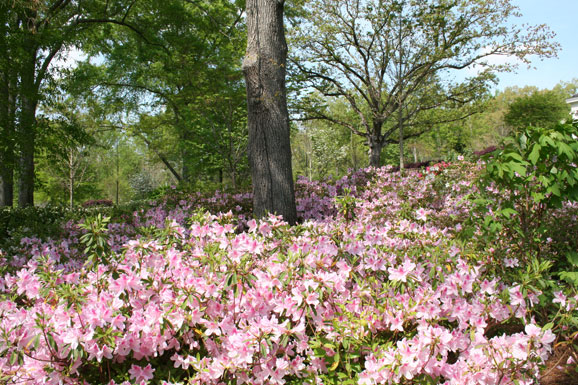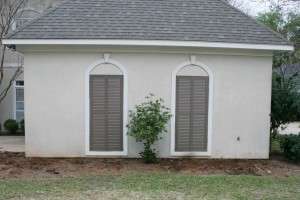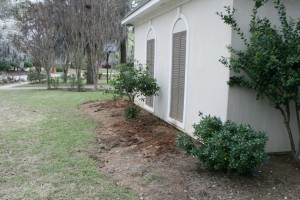
After removing old shrubs that have died, you may be asking yourself, "What should I do next?"
I recently received an email from one of our Planting to Grow subscribers who was asking himself this exact question. He emailed me the photos listed below, and was wondering what his next plan of action should be.
Should he remove the older Sweet Olive (
Osmanthus fragrans) in the center? What should he plant instead?
 5 Top Considerations Before Planting:
5 Top Considerations Before Planting:
1. Why did the old plants die? This will give you the answers to what needs to be corrected before adding new plants. In this case, after 20 years of growth, the shrubs had gotten too large for the allotted space. After unsuccessfully pruning the shrubs, they eventually died. The homeowner then decided to start over anew and removed the old plantings.
2. What are the conditions of the area? Is the area in full sun, facing north, dry, wet, windy? You don't want to plant a shade loving plant in a sunny location. The area that belongs to our homeowner gets 8 hours of full sun everyday. He expressed that he would like a blooming shrub, that stays in about the 2-3' height at maturity. After researching his options, he decided to use an Encore Azalea.

3. Has the soil been prepared for new shrubs? Even if the area has had plants in it for 20 years, the soil still needs to be broken up and mixed with soil conditioner which makes the soil more loose before adding new shrubs. In the sandy clay soils of Oxford, you should use 1-2 inches of soil conditioner spread that has been tilled into the earth about 8" deep. The local garden center can sell this to you by the bag or in bulk quantities for large jobs.
4. Does the area have good drainage? Before planting is the time to confirm that the area is draining correctly. How do you do this? Dig a hole 1 foot wide by 1 foot deep, in the location where you would like to plant your shrub. Fill the hole with water. If the water drains at least 1 inch in 30 minutes, the drainage is considered adequate. If the water level doesn't drop at all within 30 minutes, then you will need to correct the drainage before you plant.
5. Dig a great planting hole. This is the the part that you won't want to skimp on! Dig a hole twice the width as the diameter of the plant growing pot, but no deeper than its height. Dig the edges of the hole at a 45-degree angle. Remove the plant from the grow pot and gently massage the roots so that they will grow outward. Set the plant in the hole and add the soil previously dug out, back around the shrub. Gently, pack the soil around the shrub with your foot to prevent any air pockets. Do not add water to the shrub until planting is complete.
 After removing old shrubs that have died, you may be asking yourself, "What should I do next?"
I recently received an email from one of our Planting to Grow subscribers who was asking himself this exact question. He emailed me the photos listed below, and was wondering what his next plan of action should be.
Should he remove the older Sweet Olive (Osmanthus fragrans) in the center? What should he plant instead?
After removing old shrubs that have died, you may be asking yourself, "What should I do next?"
I recently received an email from one of our Planting to Grow subscribers who was asking himself this exact question. He emailed me the photos listed below, and was wondering what his next plan of action should be.
Should he remove the older Sweet Olive (Osmanthus fragrans) in the center? What should he plant instead?
 5 Top Considerations Before Planting:
1. Why did the old plants die? This will give you the answers to what needs to be corrected before adding new plants. In this case, after 20 years of growth, the shrubs had gotten too large for the allotted space. After unsuccessfully pruning the shrubs, they eventually died. The homeowner then decided to start over anew and removed the old plantings.
2. What are the conditions of the area? Is the area in full sun, facing north, dry, wet, windy? You don't want to plant a shade loving plant in a sunny location. The area that belongs to our homeowner gets 8 hours of full sun everyday. He expressed that he would like a blooming shrub, that stays in about the 2-3' height at maturity. After researching his options, he decided to use an Encore Azalea.
5 Top Considerations Before Planting:
1. Why did the old plants die? This will give you the answers to what needs to be corrected before adding new plants. In this case, after 20 years of growth, the shrubs had gotten too large for the allotted space. After unsuccessfully pruning the shrubs, they eventually died. The homeowner then decided to start over anew and removed the old plantings.
2. What are the conditions of the area? Is the area in full sun, facing north, dry, wet, windy? You don't want to plant a shade loving plant in a sunny location. The area that belongs to our homeowner gets 8 hours of full sun everyday. He expressed that he would like a blooming shrub, that stays in about the 2-3' height at maturity. After researching his options, he decided to use an Encore Azalea. 3. Has the soil been prepared for new shrubs? Even if the area has had plants in it for 20 years, the soil still needs to be broken up and mixed with soil conditioner which makes the soil more loose before adding new shrubs. In the sandy clay soils of Oxford, you should use 1-2 inches of soil conditioner spread that has been tilled into the earth about 8" deep. The local garden center can sell this to you by the bag or in bulk quantities for large jobs.
4. Does the area have good drainage? Before planting is the time to confirm that the area is draining correctly. How do you do this? Dig a hole 1 foot wide by 1 foot deep, in the location where you would like to plant your shrub. Fill the hole with water. If the water drains at least 1 inch in 30 minutes, the drainage is considered adequate. If the water level doesn't drop at all within 30 minutes, then you will need to correct the drainage before you plant.
5. Dig a great planting hole. This is the the part that you won't want to skimp on! Dig a hole twice the width as the diameter of the plant growing pot, but no deeper than its height. Dig the edges of the hole at a 45-degree angle. Remove the plant from the grow pot and gently massage the roots so that they will grow outward. Set the plant in the hole and add the soil previously dug out, back around the shrub. Gently, pack the soil around the shrub with your foot to prevent any air pockets. Do not add water to the shrub until planting is complete.
3. Has the soil been prepared for new shrubs? Even if the area has had plants in it for 20 years, the soil still needs to be broken up and mixed with soil conditioner which makes the soil more loose before adding new shrubs. In the sandy clay soils of Oxford, you should use 1-2 inches of soil conditioner spread that has been tilled into the earth about 8" deep. The local garden center can sell this to you by the bag or in bulk quantities for large jobs.
4. Does the area have good drainage? Before planting is the time to confirm that the area is draining correctly. How do you do this? Dig a hole 1 foot wide by 1 foot deep, in the location where you would like to plant your shrub. Fill the hole with water. If the water drains at least 1 inch in 30 minutes, the drainage is considered adequate. If the water level doesn't drop at all within 30 minutes, then you will need to correct the drainage before you plant.
5. Dig a great planting hole. This is the the part that you won't want to skimp on! Dig a hole twice the width as the diameter of the plant growing pot, but no deeper than its height. Dig the edges of the hole at a 45-degree angle. Remove the plant from the grow pot and gently massage the roots so that they will grow outward. Set the plant in the hole and add the soil previously dug out, back around the shrub. Gently, pack the soil around the shrub with your foot to prevent any air pockets. Do not add water to the shrub until planting is complete. 